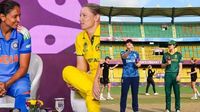As the 2025 ICC Women’s Cricket World Cup barrels toward its dramatic conclusion, the cricketing world finds itself gripped by a pair of semi-final showdowns brimming with intrigue, nerves, and—perhaps most unpredictably—threatening skies. With Australia, India, England, and South Africa all vying for a coveted place in the final, the stage is set for a thrilling climax, but Mother Nature may yet have her own say in how the action unfolds.
Australia, the defending champions, have been nothing short of dominant throughout the group stage, sweeping aside all challengers to reach the knockouts unbeaten. Their campaign crescendoed with a clinical dismantling of South Africa, bowling them out for just 97 runs—a statement of intent that reverberated through the tournament. Even when faced with adversity, such as their precarious slump to 76-7 against Pakistan, the Aussies found a way to bounce back. Beth Mooney’s sublime century in that match rescued her side, lifting them to a competitive 221-9 and reinforcing why Australia are widely seen as the team to beat.
What’s the secret sauce behind Australia’s sustained supremacy? According to captain Alyssa Healy, it’s the team’s extraordinary depth and collective belief. “It’s been the nature of the tournament where teams have struggled at the top,” Healy told BBC’s No Balls podcast. “I’ve been saying the whole way you’ve got to back your depth. They keep stepping up, sticking their hands up and getting the job done no matter the situation. There was frustration [against England] but no, I don’t think there was ever any worry.” That confidence is well-founded: between the 2022 World Cup and the start of this edition, Australia played 31 ODIs, winning 26 and losing just four, with one no-result. Since being knocked out by India in the 2017 semi-final, they haven’t lost a single World Cup match.
Australia’s batting line-up is the stuff of legend. Their powerplay run-rate of 6.26 is the highest in the tournament, and their strike-rates—107.2 against pace and 92.3 against spin—leave opponents gasping. The opening partnership, especially when Healy and Phoebe Litchfield are together, averages a formidable 89.8. Down the order, there’s no respite: Tahlia McGrath at seven and Georgia Wareham at eight provide a safety net, while Ash Gardner, who bats at six but could walk into any other side’s top three, has already notched two centuries in this World Cup. Mooney and Annabel Sutherland have also delivered match-defining knocks, with Sutherland’s unbeaten 98 against England marking her emergence as a premier all-rounder on the global stage.
But Australia’s firepower isn’t limited to the bat. Their bowling attack, brimming with options, has been lethal in the middle overs. Sutherland, seen as the heir to Ellyse Perry’s throne, has been particularly impressive, finishing the group stage with 15 wickets—joint top with India’s Deepti Sharma. Leg-spinner Alana King has also found her groove at the right time, with standout spells of 1-20 and 7-18 against England and South Africa, respectively.
Yet, even the best have chinks in their armor. Australia’s seamers—Kim Garth, Darcie Brown, and Megan Schutt—have occasionally struggled for economy in the opening ten overs, especially on flat or spin-friendly surfaces. While their seamers have claimed the second-most wickets in the tournament (24), both South Africa and England have been more frugal in the powerplay. This is where Sutherland or King are often called upon to regain control. Another subtle vulnerability lies in Australia’s batting when setting a target; their two closest shaves, against New Zealand and Pakistan, came when they batted first. Their death overs batting, striking at 7.55 runs per over between overs 41-50, is behind South Africa and India—perhaps an area for rivals to exploit if given the chance.
As the semi-finals loom, Australia’s path to another final is anything but straightforward. Their next challenge comes from India, a side that has shown flashes of brilliance despite three group-stage losses. India posted a mammoth 330 against Australia in the pick of the group games, only to fall 20 runs short. Notably, India is the most recent team to defeat Australia in an ODI, having edged them in a pre-World Cup series. With a home crowd behind them and a strong opening partnership in Smriti Mandhana and Pratika Rawal (averaging 82.8), India’s hopes are high—though Rawal’s knee and ankle injury casts some doubt over her availability for the semi-final.
On the other side of the bracket, England and South Africa are set for a tantalizing clash in Guwahati. England, boasting the best catching efficiency in the tournament at nearly 83%, have outperformed rivals with the ball both in the powerplay and at the death. Their spin attack is second only to Australia’s, with 37 wickets at an average of 19.2. However, their batting has lagged, particularly in the middle overs, where they score at a modest 4.55 runs per over. South Africa, meanwhile, possess the most economical powerplay bowling and the best strike rate in the death overs, thanks in large part to lower-order dynamo Nadine de Klerk.
Yet, as much as tactics and form will play a role, the weather may be the ultimate decider. The England-South Africa semi-final, scheduled for October 29 at Barsapara Stadium in Guwahati, faces a 33% chance of rain. The India-Australia clash in Navi Mumbai on October 30 is under even greater threat, with forecasts suggesting more than a 50% chance of rain. To mitigate this, the ICC has scheduled reserve days—October 30 for England vs South Africa and October 31 for India vs Australia. If rain disrupts play on the original day, every effort will be made to achieve a result, even if it means reducing the match to a 20-over contest per side, provided both teams bat at least 20 overs.
If the weather gods refuse to cooperate and the reserve days are also washed out, the rules are clear: the team that finished higher in the group stage will progress to the final. That means England would advance over South Africa, and Australia would move past India if their respective matches end without a result. It’s a harsh reality, but one that underscores the importance of every group-stage point and net run rate calculation.
As the semi-finals approach, anticipation and anxiety are in equal measure. Will Australia’s depth and composure see them through another stern test? Can India, with their passionate home support and recent success against the Aussies, spring a surprise? Will England’s fielding prowess or South Africa’s powerplay mastery tip the scales? Or will the rain clouds have the final word?
For now, all eyes remain fixed on the skies and the pitch, as cricket’s finest prepare for a semi-final stage that promises drama, excellence, and perhaps a twist or two from the elements. One thing’s certain: whoever emerges will have earned their shot at World Cup glory under the most intense pressure imaginable.




